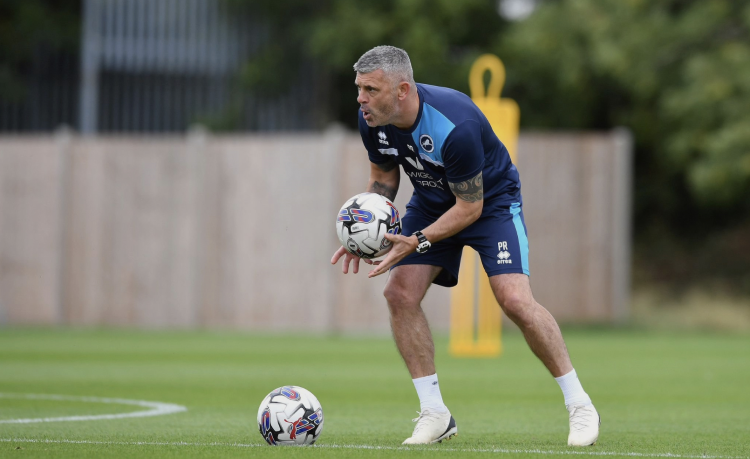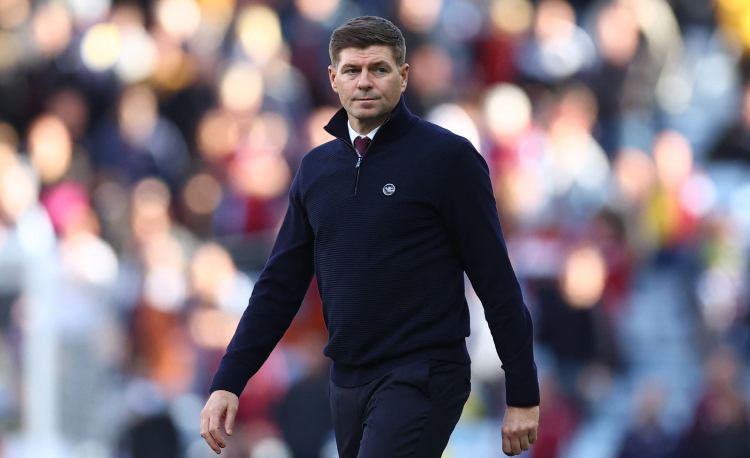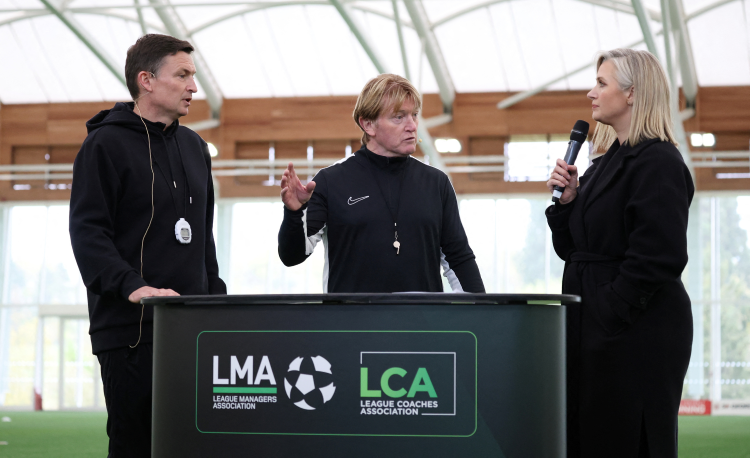You are viewing 1 of your 1 free articles
Defending crosses with a back three
| Area | Up to full pitch |
| Equipment | Balls, bibs, cones, 2 full size goals |
| No. of Players | Up to 20 players + 2 goalkeepers |
| Session Time | Pre Activation/Warm Up: 30mins Phase of Play 1: 20mins Phase of Play 2: 20mins 11 v 11: 20mins |
This session is all about setting a team up in a 3-5-2 formation and coaching them to defend against crosses from wide areas. It initially works on preventing opponents crossing from wide but it also rehearses players to defend in the penalty area if crosses come in.
I like this session because it allows coaches to experiment with the squad and during the session they can examine their players in multiple roles. For example, a full back that traditionally operates in a back four could be appropriate to serve as a wing back or indeed as a side centre back in a 3-5-2 system. Similarly, a centre back that typically operates in a back four may be able to operate as a side centre back or as the central centre back in a 3-5-2. Possible factors that will determine the best positioning of the players include physical capacity, technical ability and specific defensive qualities.
How often I run this session will depend upon the team set-up that is most appropriate for the squad and gives the team the best chance of winning the next game. If the team is very comfortable in the 3-5-2 system, it may be good to run the session for an extended period to refresh the basics of defending this way. Running it regularly could also give coaches a degree of flexibility during games, as it is often beneficial to be able to change the formation of a team without making a substitution.
“I like this session because it allows a coach to experiment with the squad and examine players in multiple roles”
PHASE OF PLAY 1
After a warm-up [not shown] the initial part of the session would be a phase of play. We set up on half of the pitch with a goal and a goalkeeper at one end. We’re using 17 outfield players.
The red team are set up to defend the goal in a 3-5-2 formation minus one striker, using three central defenders, two wing backs, and two midfielders sitting in front of the defence. The defending team would also have a number 10 and a number 9 as an outlet, should the defenders win the ball.
We would set up the blue attacking team to provide an appropriate challenge, representing the opposition in our upcoming match – in this case the blues are set up to attack the goal in a 4-2-3-1 formation, initially minus the team’s two full backs.
Often in a phase of play like this, we would ask the attacking team to mimic a particular style of play that the upcoming opponents will use. In this case, we have asked them to play a fast, possession-based brand of football, keeping the ball on the floor and using the width of the pitch to produce crosses and to score from crosses.
This part of the practice focuses on defending the final third. The starting positions of the defending red wing backs is relatively narrow, forming a back five. As this is not a transition, the red defending team are in a good shape at this stage.
Play would start from the halfway line with the blue attacking team being asked to play either into midfield or out wide. As shown [1a], the ball starts with a blue central midfield player who passes across field to a second central midfielder, who then plays out wide to the blue left winger.
[1a]
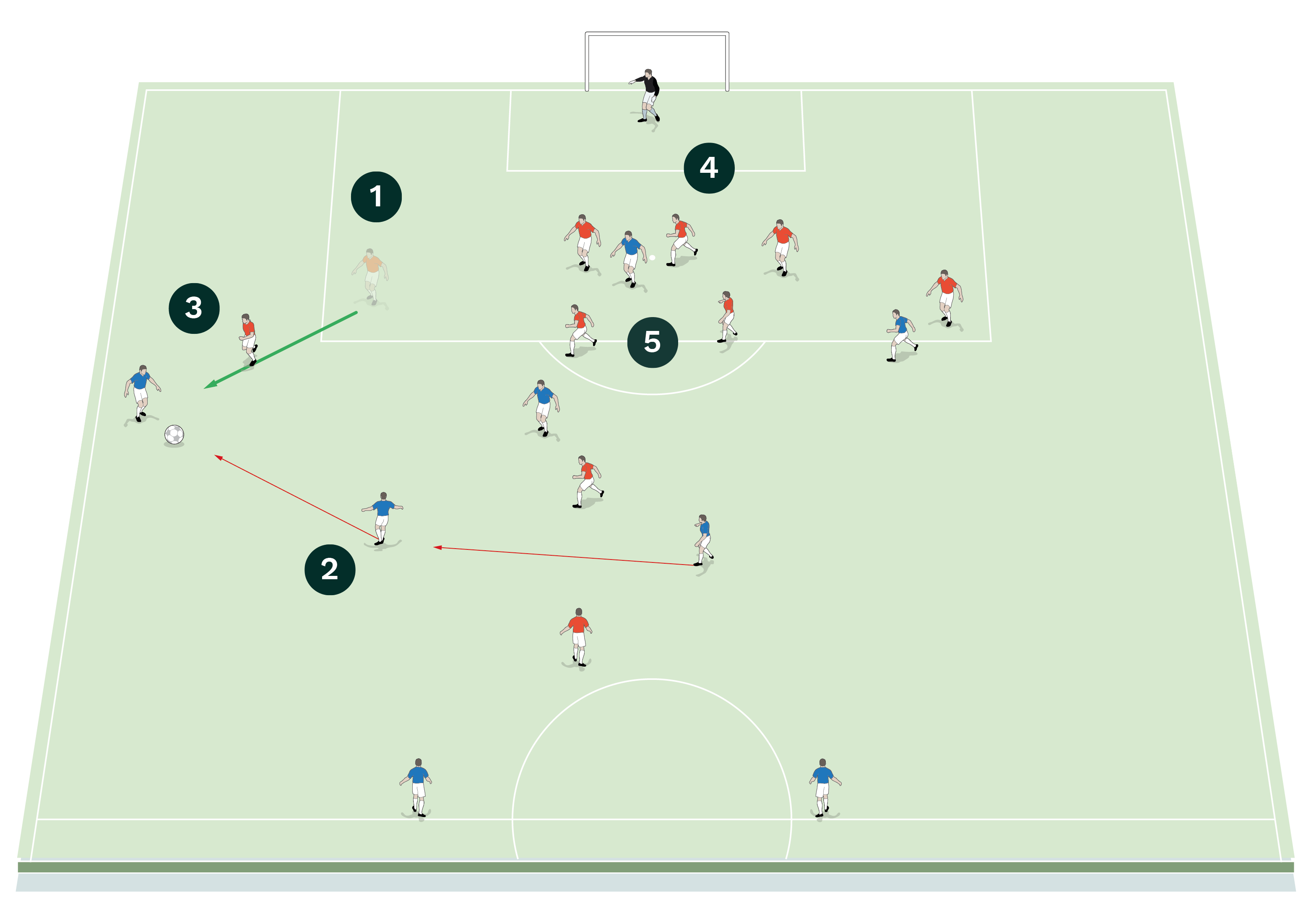
2. The blues set up to attack the goal in a 4-2-3-1 formation, minus full backs. Play starts with the blues, who pass out to the left winger
3. As the ball is travelling, the red right wing back goes out to engage the opposition winger
4. The three red centre backs must take up effective positions in front of the goal to defend a potential cross delivered into the box
5. The two red central midfielders must take up positions in front of the centre backs, ready to pick up oncoming attacking midfielders and win any second balls
[1b]

2. The red defenders must be positioned on an angle to be able to see the position of the attackers and the position, timing and flight of any incoming crosses
[1c]
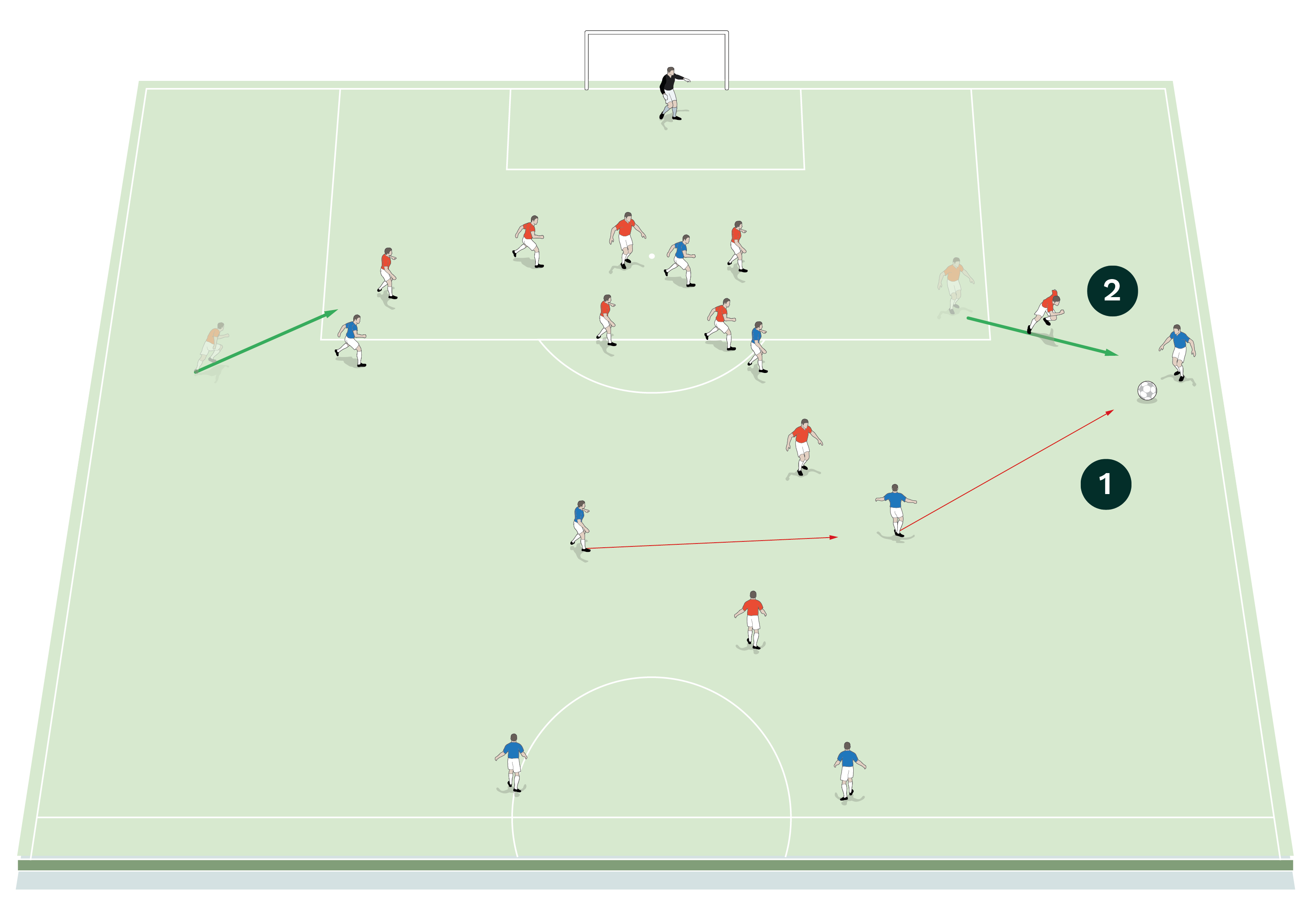
2. The red left wing back is now released from the back five to apply pressure on the ball and must try to prevent the cross
The red right wing back goes out to engage the opposition winger as the ball is travelling. He can do this without hesitation, knowing that there are three centre backs and another wing back defending centrally. The three centre backs must take up effective defending positions in front of the goal to defend a potential cross delivered into the box. The two red central midfielders must also take up their positions in front of the centre backs.
If the blue left winger is successful in delivering a cross into the box, then the red team must aim to defend and clear the ball effectively, as shown [1b]. In the event of a cross coming in, the defensive positions of the central defenders and the other wing back must be coached. They should fill slots in the zone in front of the goal, with good body shape and an awareness of the opposition team’s movements and positioning. Red defensive midfield players should also fill slots in front of the red defenders to clear crosses in that area, picking up oncoming attacking midfielders and winning second balls if the centre backs fail to make
a good clearance.
This can be repeated in waves for 20 minutes. We would run the practice on both sides of the pitch to check the understanding of each player within the defending unit, as shown [1c].
The activity can be progressed to create a more challenging situation for the defending team, with the red defenders now being asked to take up starting positions outside of the penalty area, as shown [1d]. The ball is played out wide to an opposition winger with the red wing back moving out to engage. The nearest centre back may now be required to engage on the cover if the wing back is beaten by the winger in a 1v1 situation. The other defenders in the back line and the two midfielders retreat into the box to take up appropriate defending positions in relation to the ball, including the opposite wing back who may now need to be one of the three defenders in front of the goal.
“We would run the practice on both sides of the pitch to check the understanding of each player within the defending unit”
[1d]
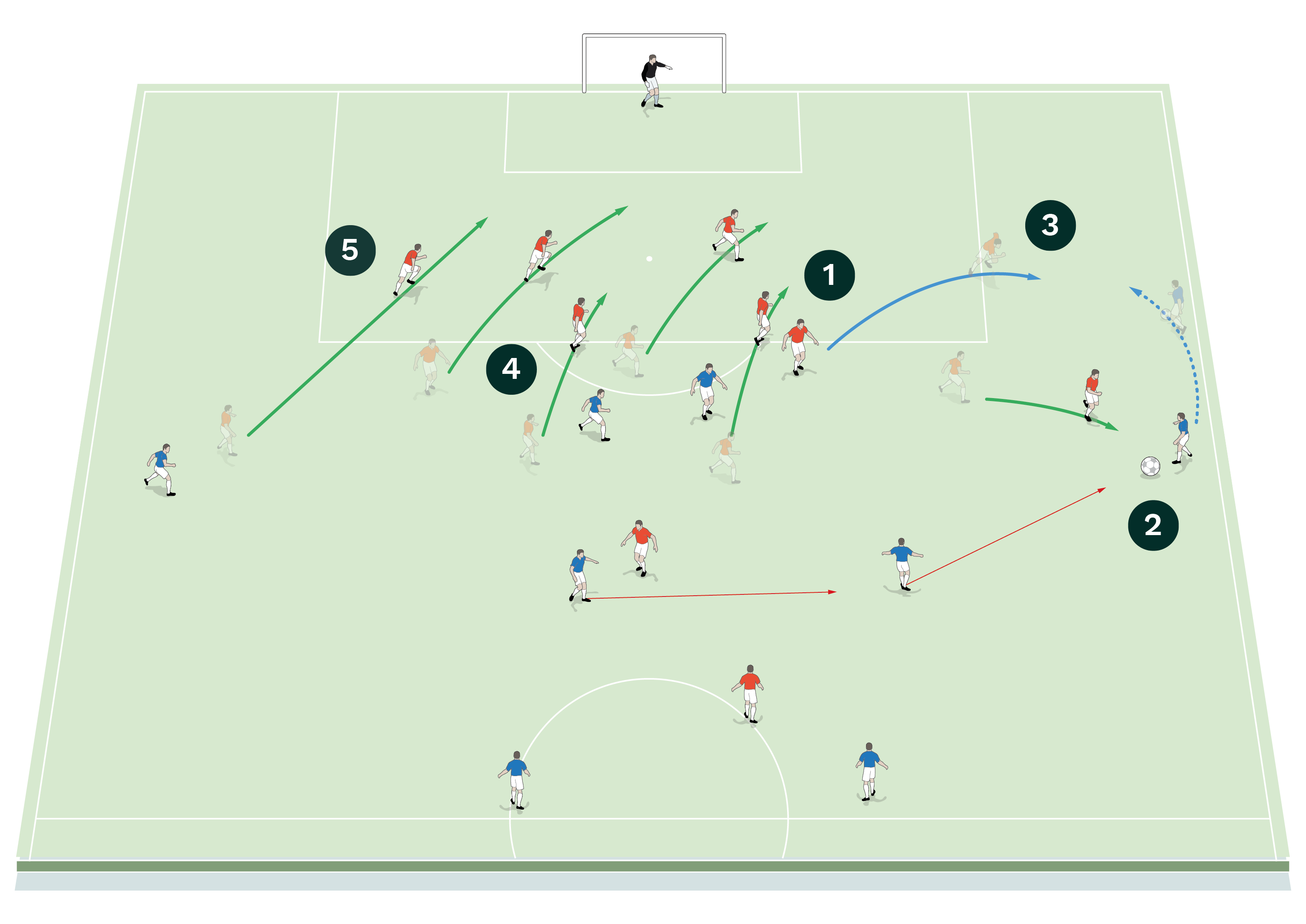
2. The ball is played out wide to a blue winger and the red wing back moves out to engage the winger
3. The nearest red centre back may now be needed to engage on the cover if the red wing back is beaten by the blue winger in a 1v1
4. The other defenders in the back line and the two red midfielders retreat into the box to take up appropriate defending positions in relation to the ball
5. The opposite wing back may need to shift over to become one of the three defenders in front of the goal
PHASE OF PLAY 2
[2a]

2. Here the red wing back goes to engage an oncoming opposition full back and is taken out of the game when the full back passes down the line to the blue right winger
3. The left sided red centre back must now come out to engage the winger and the ball in a 1v1 situation
4. Now the opposite red wing back must take up the third central defensive position in the box
The session is now progressed. The basic set up remains the same, but we’re now adding two outfield players. Previously the red defence was set up in an ‘ideal’ way. However, by adding two full backs to complete the blue attacking team’s line-up, this can give the red wing backs a dilemma. They now may have to go forward and engage an oncoming opposition full back, meaning the nearest centre back would have to come out to defend against the opposition winger in a 1v1 should the attacker receive the ball. This means the opposite red wing back may now need to shift over to become one of the three defenders in front of the goal, as shown [2a].
If the wing back and the nearest centre back to the ball are required to come out into the wide area and engage both the opposition winger and attacking full back in a 2v2 situation with the aim of stopping a potential cross, the two remaining central defenders, plus the other wing back and the two red midfielders, must retreat into the box to take up appropriate defending positions in relation to the ball, as shown [2b].
We would repeat this attack in waves for about 20 minutes, alternating the side of attack and asking the red defenders to react appropriately to defend against the attacking situation.
“One of the most important things is the speed at which the wing backs are able to get out and engage opposition players in wide areas”
[2b]
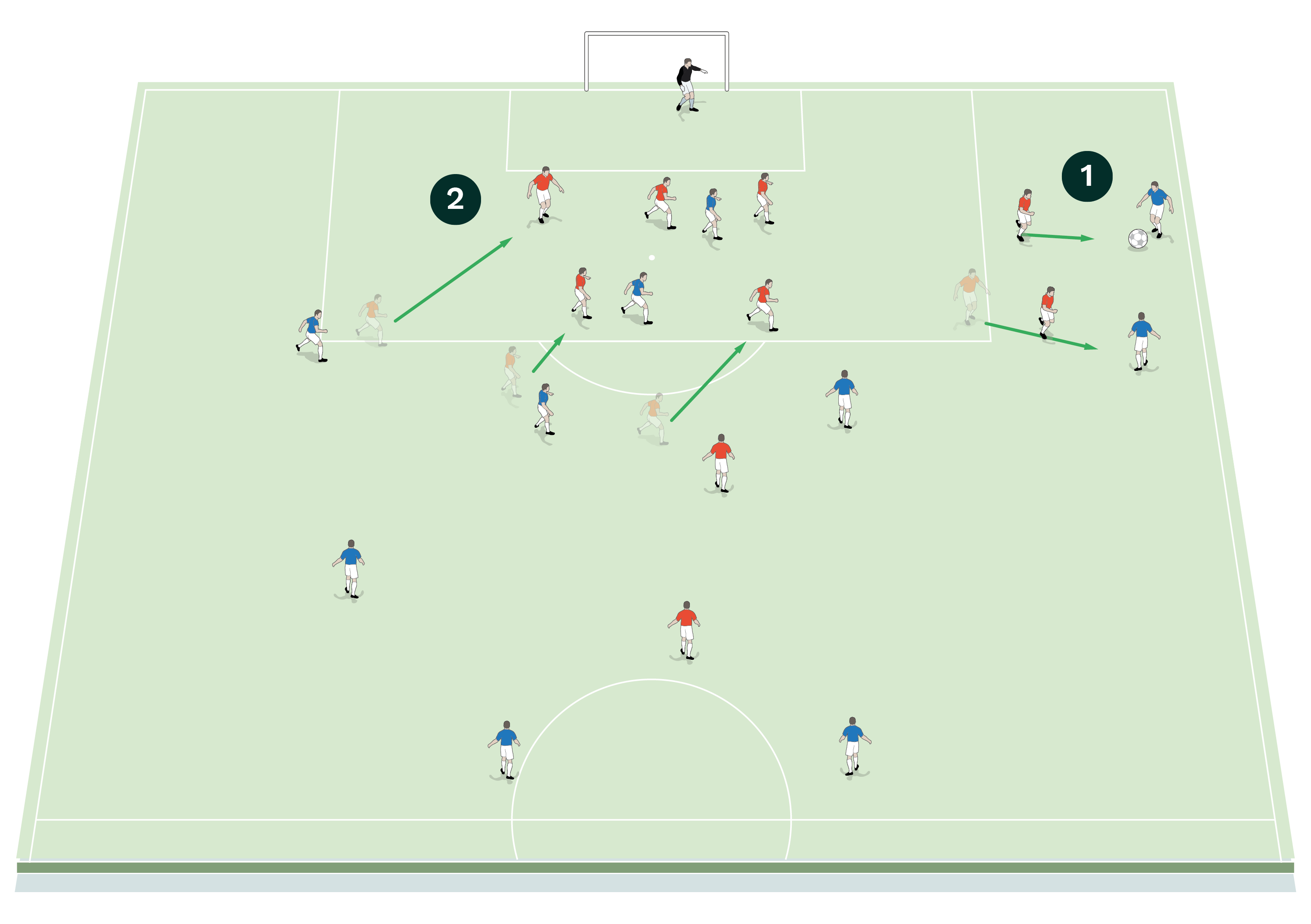
2. The two remaining red central defenders, plus the other red wing back and the two red midfielders, must retreat into the box to take up appropriate defending positions in relation to the ball in case a cross comes in
COACHING POINTS
What are the key things to look for?
One of the most important things to look at is the speed at which the wing backs are able to get out and engage opposition players in wide areas. This is particularly relevant if any specific detail about the opposition has been identified, such as the winger always comes inside to shoot, so the wing back would need to get out quickly to show the attacker down the line.
Also important is the body position of the central defenders and midfielders in the penalty box when anticipating a cross coming in. They must be positioned on an angle to be able to see the position and movement of the oncoming attackers and the position, timing and flight of any delivered crosses.
Crucially, we want to see the defensive line squeezing the penalty box after a clearance to deny space to the opposition and relieve the pressure on the goal.
The goalkeepers should play a key role in this session too. Their communication, encouragement and ability to come and claim crosses will relieve pressure in the important defensive moments of a game.
What are the typical mistakes players might make and how do I avoid them?
A typical mistake can be players being dragged out of position by the movement of the attacking players. Although attackers must be marked in the penalty area, defensive players need to communicate well, pass men on and be aware of danger. Defenders should never cross over and switch positions with each other in this situation.
Wing backs and centre backs defending wide areas should not dive in – they should stand up and deny space to the attacker. Defending against the opposite wide attacker is also important, as is the body shape of the last defender.
How would I put this in a game situation?
We can develop this session into an 11v11 game. Both teams can attack and defend, but the team coached to defend through the session should exhibit the points that have been addressed previously. By the same token, the attacking team representing our forthcoming opponents should maintain the same style of play that they used in the earlier phases of play in order to elicit the desired scenarios: defending in wide areas and against crosses.
Related Files
Editor's Picks
Using the goalkeeper in build-up play
Pressing principles
Intensive boxes drill with goals
Penetrating the final third
Creating and finishing
My philosophy
Pressing initiation
Compact team movement
Defensive organisation
Coaches' Testimonials

Alan Pardew

Arsène Wenger

Brendan Rodgers

Carlos Carvalhal

José Mourinho

Jürgen Klopp

Pep Guardiola

Roy Hodgson

Sir Alex Ferguson

Steven Gerrard
Related
Crossing, finishing and defending
Principles in possession
Coaches' Testimonials

Gerald Kearney, Downtown Las Vegas Soccer Club

Paul Butler, Florida, USA

Rick Shields, Springboro, USA

Tony Green, Pierrefonds Titans, Quebec, Canada
Join the world's leading coaches and managers and discover for yourself one of the best kept secrets in coaching. No other training tool on the planet is written or read by the calibre of names you’ll find in Elite Soccer.
In a recent survey 92% of subscribers said Elite Soccer makes them more confident, 89% said it makes them a more effective coach and 91% said it makes them more inspired.
Get Monthly Inspiration
All the latest techniques and approaches
Since 2010 Elite Soccer has given subscribers exclusive insight into the training ground practices of the world’s best coaches. Published in partnership with the League Managers Association we have unparalleled access to the leading lights in the English leagues, as well as a host of international managers.
Elite Soccer exclusively features sessions written by the coaches themselves. There are no observed sessions and no sessions “in the style of”, just first-hand advice delivered direct to you from the coach.






